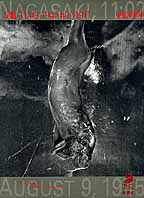TOMATSU Shomei
TOMATSU Shomei 東松 照明 (1930.1.15-2012.12.14) Nagoya, Aichi Pref. A major figure in fine-art and documentary photography. Based in Nagasaki.
Major themes Nagasaki, Okinawa, war-related issues
Education Attended high school in Nagoya, 1942-46; studied economics at Aichi University, 1954. Self-taught in photography.
Career Photographer since 1951. Founding member of the Vivo group of photographers, Tokyo, 1959. Director, Japan Professional Photographers Society, 1959. Professor, Tokyo University of Art and Design, from 1966.
Covered the post-war Occupation, atom bomb victims, conflicts concerning the American bases on Okinawa (since the late 1960s), and other social upheavals. Lived in Okinawa for a while from 1972. Moved to Nagasaki in 1998.
For his Nagasaki photos titled, "Nagasakiム11:02," he said that Nagasaki has two times: Aug. 9, 1945, 11:02 (when the bomb exploded) and all the time since then (during which the suffering continued). "Both times must not be forgotten." (2000.12.20)
Awards Most Promising Photographer Award, Japan Photo Critics Association, 1958; Photographer of the Year. Award, Japan Photo Critics Association, 1961; Photographic Society of Japan Award, 1975; Mai-nichi Art Award, 1976; Art Encouragement Award, Ministry of Education, 1976; Medal with Purple Ribbon, 1995.
Sample photos https://fujifilmsquare.jp/profile/shomei_tomatsu.html
Nagasaki, 11:02 Aug. 9, 1945 - 長崎「11:02」1945年8月9日
 Reviewed on: July 20, 1999
Last modified: 2005-04-03
Reviewed on: July 20, 1999
Last modified: 2005-04-03
Photos of Atom bomb survivors & artifacts. Educational book about the effects of the atomic bomb dropped on Nagasaki.
人類最大の悲劇が美術的に写っている。学校の教科書になってもいい本。
Published: June 25, 1995 Publisher: Shinchosha ISBN: 410602411X Price in Japan: ¥2040 Qualities: Soft cover, B/W photos Size: A5, 157 pp. Language: Japanese and English
This is one of the most important photographic works on post-atomic bomb Nagasaki. They have been published and exhibited before, and this low-cost book strives to prevent people from forgetting. Tomatsu is an extraordinary art photographer who grapples with social issues. These photos of Nagasaki are one of his hallmark series.
The book's title refers to the time and date of the bomb's explosion. It was a hot and sunny morning with no wind when the atomic bomb was dropped by parachute from an altitude of 9,600 meters. When it floated down to about 500 meters above the ground, it exploded over the northern part of the city called Urakami at 11:02 AM, August 9, 1945. That instant forever changed lives of over 200,000 people who were in the city at the time. Over 70,000 people died, and over 70,000 people suffered injuries that day.
The book includes these facts about the bombing as well as diary excerpts and essays by a few of the survivors. English translations are provided, and they are much more graphic than the photographs which were taken in the 1960s. They describe "people walking with their skin hanging off them like old rags" and "people running from left to right like spinning lanterns (on fire)."
The suffering, of course, continued long after the bombing. Ten years later in 1955, one survivor named Sumako Fukuda developed red blotches on her skin. She applied for medical assistance from the city, but received no reply. In August 1955, the city was going to unveil a statue for peace. It was just like a festival, she thought. And for what reason? Put up all those memorials for the dead while doing nothing for the sick survivors? "Why were we, the surviving victims, pushed aside like some stray animal?" she wondered. (Later in 1957, a law was passed for the government to shoulder the health care and medical expenses of hibakusha atomic bomb survivors. In 1958, the Nagasaki Atomic Bomb Hospital opened.)
Of course, the suffering continues until this day, even though the city itself shows hardly a trace of the devastation inflicted by the bomb. Tomatsu says that there are two times in Nagasaki: Aug. 9, 1945, 11:02 and all the time since then.
His pictures are inspired by the double aspect of misery interwined with the city's post-war propserity. Through photography, he strives to tell the survivors' stories which he admits are only a small sample and not representative of everyone. The photographs are a mixture of deformed objects and disfigured faces of people who survived the atomic blast and ordinary scenes and things in 1960s Nagasaki.
Among the more famous images in this collection are a melted bottle (see the book's cover), a wristwatch which was dug up and indicated 11:02, broken statues of angels from Urakami Cathedral, a helmet with skull fragments fused to it on the inside, a brazier whose surface was blistered by the heat of the blast, the blistered and blotched arm of Sumako Fukuda, the disfigured keloid face and neck of Senji Yamaguchi in dramatic lighting, and the keloid face of Tsuyo Kataoka. (Keloid is the abnormal growth of scar tissue.) This book can easily serve as a supplemental textbook for junior high and high school history classes. (Reviewed by Philbert Ono)